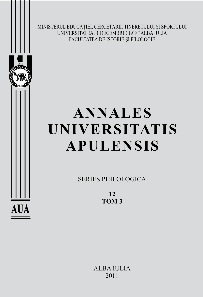Reportaj publicistic vs. reportaj literar. Deturnarea realităţii spre propagandă în perioada proletcultistă. Studiu de caz – F. Brunea-Fox
Journalistic Report vs. Literary Report .Turning Reality into Propaganda during the Proletcultist Period. A Case Study – F.Brunea –Fox
Author(s): Alexandru GruianSubject(s): Literary Texts
Published by: Universitatea »1 Decembrie 1918« Alba Iulia
Keywords: reportage; journalism; communism; propaganda; F. Brunea-Fox
Summary/Abstract: Often named „literary species of frontier”, sometimes „obliged” to obey the rules of literary theory with arguments about narrative amplitude, elaborated style and author notoriety, the reportage originally was and still is to a great extent a journalistic genre. Essentially based on the construction rules imposed by the journalistic presentation of a real event, unchanged and unprocessed, but placed in a broader context so as to permit the analysis of causes and consequences, the portrayal of the actors, the analysis of their psychic. The author may appeal to introspection, using autoreferentiality, occupying two positions, as a receiver and speaker for the public, conveying the emotions resulted from his implication in the event. However, the journalistic reportage presuposes sharing the paradigm of the so-called balanced journalistic presentation, that takes into account all or at least as many points of view as possible, including the author’s (this is what differentiates it from the press report in a fundamental way). Regarded as a star-journalist in the years 1930 – 1937, F. Brunea-Fox would produce texts taken by the Romanian interbelic mass-media as reference, characterised by an alert style, depth in the analysis of the social problems he approached, contextualisation, objectivity. The force of his texts can be quantified according to the responses of those targeted, especially the authorities of the time, extremely sensitive to press-transmitted messages. „Five Days Among the Lepers”, „Maltese Adventures”, „Beggars’ Trust”, „Slaughter City – 1941 – the journal of the legionary murders and crimes”, these are just a few of the reportages signed by Brunea-Fox that transformed him into a landmark for what Romanian journalism stands for. As a member of the literary vanguard, even if on a peripheral position, he entered the interbelic artistic world and his vast culture helped him understand the meaning of events. The liberty of expression, progressively reduced after 1944, was replaced by total censorship beginning with 1948. Brunea-Fox tried to adapt to political instructions which encouraged the transformation of journalistic reportage into literary reportage – practically, a vast travel diary, highly descriptive, whose unmached master became Geo Bogza, another vanguardist. The gain of the literary reportage in style and vocabulary was counterbalanced by the slide towards propaganda. The authors’ credibility and talent were used or diverted for transmitting distorted information to the public, who was denied the access to the correct perception of reality. In 1957, Brunea-Fox published a cycle of three reportages grouped in the work „The Pirate’s Skull. Danube Landscapes”, in the obvious communist style of the ’50s. It is interesting to observe both the efforts to eludate the official instructions, by using stylistic strategies like virtually going back in time, as well as the appearance of appreciative language characterised by
Journal: Annales Universitatis Apulensis. Series Philologica
- Issue Year: 12/2011
- Issue No: 3
- Page Range: 69-76
- Page Count: 7
- Language: Romanian

